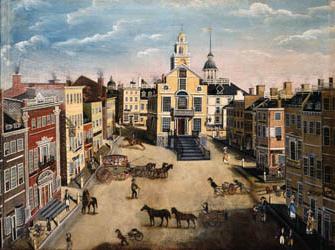State Street, 1801
To order an image, navigate to the full
display and click "request this image"
on the blue toolbar.
This painting shows the eastward side of the Old State House as it looked at the turn of the eighteenth century, just a few years after the "new" State House on Beacon Hill became the seat of Massachusetts state government. On this site a Town House was erected in 1658-a building which served as the center of civic life until it burned to the ground in 1711. A second structure replaced that one, but it too burned in 1747. Again, from the ashes arose another building, the present architectural land-mark called the Old State House.1
For the next half century the building was used by governors, councils, and the General Court. The open square, shown in this painting as a place of social and commercial activity, was the scene of many memorable events, including the Boston Massacre which occurred there on 5 March 1770. The balcony above the large door looked toward the harbor, and behind it was the Council Chamber where John Hancock was inaugurated as the Commonwealth's first governor. It was from this balcony that the first public reading in Boston of the Declaration of Independence was delivered on 18 July 1776. Later, on 23 April 1783, the Proclamation of Peace, marking the end of the Revolutionary War, was read from the same spot.2
At the beginning of the nineteenth century the Old State House was subdivided and fitted for shops and offices. In 1830 its owner, the City of Boston, took it over as City Hall. After ten years it reverted to commercial use, and by 1880 there were more than fifty professional and business people working there. At last, in 1882, the newly formed Bostonian Society installed a museum in the Old State House and assumed the once and future responsibility for the building's restoration and maintenance as an historical site.3 One of the present-day threats to the continuing health of the building is from the rumbling of the subway trains that run beneath its basement, and a major structural restoration of the building is currently underway to prevent further damage.
In Marston's depiction of the Old State House as the centerpiece of a lively urban scene, the details of costume and occupation afford a pleasant impression of city life in 1801. It shows the building painted ochre with white trim and with an imposing grand staircase. The building to the right where the sign "Union" appears was originally the home of John Apthorp, remodeled by Apthorp's grandson Charles Bulfinch in 1799 to be the location of the Union Bank.4 It stands on the site of the Custom House of Boston Massacre fame.
The artist James Brown Marston, a native of Salem, was in the commercial painting business in Boston from at least 1803.5 Like many artisans, he became a member of the Massachusetts Charitable Mechanics Association, an organization of master craftsmen. Marston was also active in the military, as a captain in the state militia and a member of the prestigious Ancient and Honorable Artillery Company.6 Little is known of Marston as an artist. His only other located painting is a portrait of Governor Caleb Strong (1807), also at the Historical Society.
1.Howe, M. A. DeWolfe. Boston Landmarks. New York, 1946, pp.18-32.
2.Harris, John. The Boston Globe Historic Walks in Old Boston, Chester, Conn., 1982, pp.198-204.
3.Chase, Sara. “ A Brief Survey of the Architectural History of the Old State House, Boston, Massachusetts.” Old-Time New England 68 (1978), pp.31-48.
4.Kirker, Harold. The Architecture of Charles Bulfinch. Cambridge, Mass., 1969, p.368.
5. Vital Records of Salem, Massachusetts, to the end of the year 1849. Salem, 1916-1925, 2:58; Boston Directory, 1803.
6.Buckingham, Joseph T., comp. Annals of the Massachusetts Charitable Mechanics’ Association. Boston, 1853, p.73; Oliver Ayer Roberts. History of the Military Company of the Massachusetts, Now Called The Ancient and Honorable Artillery Company of Massachusetts. Boston, 1895-1901, 2:348.

